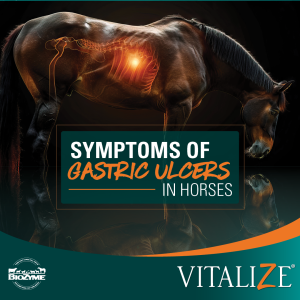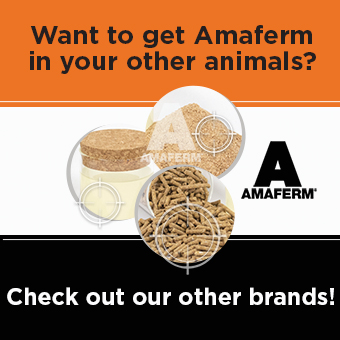
Gastric health is achieved when the stomach of the horse is free of disease and discomfort. Unfortunately, in most horses the incidence of gastric ulcers is high, ranging between 50 to 90%. Why? The horse’s stomach continuously secretes hydrochloric acid throughout the day and night, regardless of if feed has been ingested. High acid in the stomach, especially in an empty stomach, predisposes the horse to gastric ulcers.
What Are Gastric Ulcers?
Equine gastric ulcer syndrome (EGUS) is commonly diagnosed amongst all types of horses. The incidence is especially high in competition and performance horses. Gastric ulcers are due to the erosion of the lining of the stomach caused by prolonged exposure to the normal acid in the stomach. Unlike ulcers in humans, bacteria do not appear to cause equine gastric ulcers. Horses are designed to graze, with regular forage and roughage intake. Therefore, the stomach continually secretes acid, so gastric ulcers can result when the horse is not eating regularly due to less feed to neutralize the acid.
There are two common types of gastric ulcers in horses: squamous and glandular. The first third of the stomach is the squamous region, whereas the last two-thirds is referred to as the glandular region. Both of these regions can develop ulcerations.
Squamous Ulcers in Horses
Squamous ulcers in horses generally occur as a direct result of ongoing exposure to stomach acid. These ulcers tend to form quickly, and they are often associated with high starch diets, lack of ample forage, intense exercise and stress.
The squamous region is more susceptible to ulcers than the glandular region since it does not produce mucous or bicarbonate. Gastric acid can also splash into this region and cause ulcers, particularly when the stomach is empty or when the horse is exercising.
Glandular Ulcers in Horses
Glandular ulcers in horses typically occur when the protective mucus layer that the glands produce is compromised. These ulcers develop slowly, and the exact causes are less well understood. Glandular ulcers are less common than squamous ulcers, and they are also more difficult to resolve.
Is My Horse at Risk for Ulcers?
Unfortunately, many horses are at high risk of developing ulcers. The common risk factors for gastric ulcers include:
- Lack of turnout/grazing
- Inadequate forage intake
- Prolonged use of NSAIDs
- Travel
- High starch diets
- Elevated exercise
- Stress
Many of these risk factors go hand-in-hand with performance horses, creating the perfect storm for ulcers. In fact, a research study in 2011 showed the prevalence of squamous ulcers in horses during the competition season was 93%, but in the off-season, the prevalence of ulcers in the same horses dropped to only 48%.
Can my Horse tell me it has Ulcers?
Gastric ulcers can only be definitively diagnosed and graded based on endoscopy (also known as “scoping”). Both squamous and glandular ulcers are graded on a scale of 0 to 4, with 0 being healthy and 4 being extensive, deep ulcerations.
Signs and Symptoms of Gastric Ulcers in Horses
Although scoping is the only sure way to know if your horse has ulcers, there are several tell-tail signs of gastric ulcers including:
Poor body condition
Has your horse’s body condition decreased recently? This can be a sign of gastric ulcers. If your horse’s digestive tract is not feeling up to par, your horse likely isn’t wanting to eat, and if it is, it might not be converting the nutrients into flesh. A decrease in fleshiness or body condition is often one of the first signs of an ulcer.
Poor appetite
One of the most prevalent signs of ulcers is the unwillingness to finish meals or becoming a finicky eater. This is probably due to the continuous abdominal discomfort your horse is experiencing. Your horse might start eating grain but be on and off diet. Some horses will balk at eating hay as well.
Weight loss
If your horse’s appetite is dwindling, and it is losing body condition, weight loss is likely to occur. However, weight loss isn’t only due to not eating. It can occur from a decreased absorption of nutrients which is linked with more severe cases of EGUS. Nutrient malabsorption happens when the lining of the stomach or small intestine has been damaged.
Digestive upset
If you don’t have an appetite, and you’re not eating, your stomach likely isn’t feeling its best. The same can be said for your horse. It’s the domino effect of poor appetite, weight loss and the excess secretion of acid in the stomach all leading to digestive upset.
Bad behavior, especially seen in girthiness/cinchiness
Sometimes your horse fusses when its girth is tightened. This is often a sign of ulcers in horses, and may be a result of the pain caused by the ulcers.
Irritability or discomfort near the flanks
Just as the horse can seem girthy, this irritability can extend into the flank area. Unusual irritability discomfort in or around the flank can be a sign of ulcers. You may notice this when brushing the horse’s sides.
Reduced performance
Intense exercise can cause an increase in abdominal pressure that causes the stomach to compress. This pushes acid from the bottom glandular region to nonglandular or squamous region, putting it in direct contact with intestinal cells that lack natural defenses to neutralize the acid.
Ulcers in the nonglandular region of the stomach are similar to lesions that cause heartburn or gastric reflux disease (GERD) in human athletes who complain of upper GI pain during exercise.
Dull coat condition
A horse’s hair coat and healthy shine is directly related to its diet and absorption of the necessary nutrients. If it is not eating properly or absorbing the nutrients it needs for a healthy, shiny coat, you might notice a duller hair coat or more shedding than normal.
Acute colic
In one study, 83% of horses with recurring colic were found to have gastric ulcers. Researchers directly linked ulcers to colic in 28% of those horses.
Diarrhea
Diarrhea is common when a horse has an ulcer. Yet, it is a symptom of other illnesses or even occurs when the weather changes or when we make changes to the horse’s diet. Just because your horse may experience diarrhea, don’t assume it is a gastric ulcer. However, if it is chronic diarrhea, you definitely want to seek the attention of a veterinarian.
Any of these signs may indicate ulcers are present, which can be confirmed via endoscopy. You can also work to help prevent ulcers by trying to minimize factors that contribute to the problem.
Tips to Prevent Gastric Ulcers in Horses
Provide Plenty of Forage
Remember that horses are natural grazers. To help prevent ulcers, be sure they have plenty of high-quality hay throughout the day. You can’t judge a book by its cover, so be sure to have your hay tested to make sure it isn’t lacking any nutrients.
Provide Ample Turnout
Turning out your horses throughout the day offers two benefits. If they have a grassy paddock, it allows them to graze, helping line their stomach and use their digestive system. It also allows them to exercise, which in turn helps their digestive tract, and will help with the prevention of ulcers.
Incorporate more Frequent Meals
Since horses are natural grazers, they typically would graze up to 18 hours in a day. Constant grazing means their stomach is never empty. If you only feed your horse twice a day, that gives several hours throughout the day when the stomach is empty, making the horse more susceptible to ulcers. Smaller intermittent meals throughout the day or at least free-choice hay allows the stomach to remain fuller. The stomach contents help neutralize the acid inside of it, helping prevent ulcers.
Provide Clean, Fresh Water
Water is the most important nutrient to every species. Water helps dilute gastric fluids, reducing the acidity found in the stomach. It also supports gut motility, which refers to moving food through the gastrointestinal tract.
Your horse should have constant access to clean, fresh water to help prevent ulcers. Be sure to stop when traveling to water your horse on long trips.
Decrease Stress, as Much as Possible
Just like stress can cause ulcers in humans, stress can lead to ulcers in horses. Try to reduce the stress you put on your horse as much as possible by keeping a consistent routine, feeding a consistent ration and limiting excessive exercise and travel, when possible.
Feed a Preventative Supplement to Help Protect the Stomach
Maintaining a good gut health program with products like Vitalize® is also paramount. In fact, while all Vitalize products benefit overall gut health, Vitalize® Alimend® is specifically formulated to support gastric health and GI tissue, which may relieve occasional gastric issues commonly associated with training, traveling and performance.
Natural Care for Existing Gastric Discomfort
If your horse is showing signs of gastric discomfort, we suggest starting it on the stress dose of Vitalize Alimend (2 pumps each morning and 2 pumps each evening). Alimend is a natural product that supports the gastric health of the horse.
It contains MHB3® Hyaluronan, beta-glucans from a Lion’s Mane mushroom extract to support the gut and immune system and AO-Biotics® Amaferm®, a prebiotic research-proven to enhance digestibility. MHB3 Hyaluronan is a multi-patented high molecular weight HA that helps hydrate tissue. In clinical trials, it has been shown to reduce gastric discomfort in over 90% of horses. It contains MHB3® Hyaluronan, Beta-glucans to support the gut and immune system and AO-Biotics® Amaferm®, a prebiotic research-proven to enhance digestibility.(Slovis, 2017). MHB3’s unique properties confers a greater response than any other hyaluronan available on the market.
Why Alimend?
Alimend is unique from other gastric health products because it does not change the pH of the stomach, nor does it prevent acid secretion as many other products do. Because of this, digestion is not negatively impacted, which decreases the chance of negative side effects.
Instead of suppressing acid, Alimend’s formula has a mucoadhesive effect that lines the stomach and is designed to maintain the integrity of the GI tissue. This helps maintain “a good gut feeling.”
Additionally, Alimend utilizes a high molecular weight and highly concentrated hyaluronan for maximum results, as well as a research-proven prebiotic for added gut health, absorption , and support of the immune system. It is palatable, easy to feed, and contains only natural ingredients.
BioZyme Produces Safe, Accurate Products
BioZyme® Inc., the makers of Vitalize prides itself on producing safe, accurate products for the equine and livestock industries. BioZyme is a member of the National Animal Supplement Council (NASC), and its Vitalize products carry the NASC Quality Seal specifically designed for the equine and companion animal health markets.
Additionally, Vitalize utilizes an ionophore-free closed production system. BioZyme has taken great care to ensure that our Vitalize products are safely made and have no risk of ionophore contamination. Finally, several Vitalize equine supplements, including Alimend, were recently Clean Sport tested. Clean Sport testing guidelines were compliant with United States Equestrian Federation (USEF), International Federation for Equestrian Sports (FEI), and the International Federation of Horseracing Authorities (IFHA).
Give your Horses a Good Gut Feeling Today
Are you looking for a way to help prevent gastric ulcers and other digestive issues in your horses? Do you want to give your horses the good gut feeling they deserve? It’s time to add Vitalize Alimend to your feed room. You can purchase it online on our website or through one of BioZyme’s online retailers.
If you want to shop locally, you can search for your local BioZyme dealer on our website.
We offer a plethora of other products and educational information through a monthly email. Sign up now to receive that information.
You can also view all the other Vitalize equine and canine products on our website.


